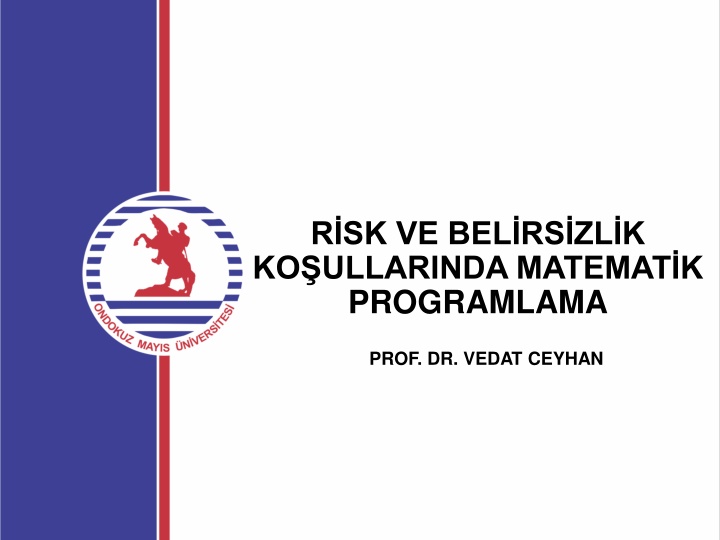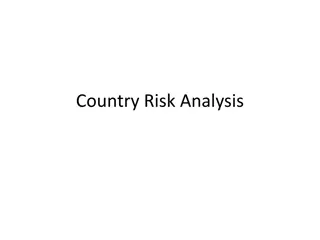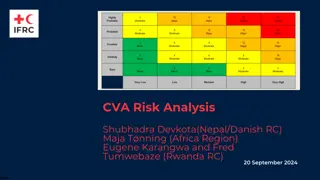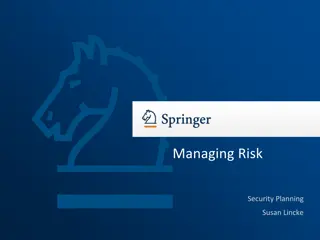
Risk Management in Mathematical Programming Techniques
Learn about risk management in mathematical programming techniques, including linear and quadratic risk programming, expected variance and mean absolute deviation criteria, E-A to E-V transformation, and utility-efficient programming. Discover how these techniques help address uncertainties and risks in decision-making processes within different environments.
Download Presentation

Please find below an Image/Link to download the presentation.
The content on the website is provided AS IS for your information and personal use only. It may not be sold, licensed, or shared on other websites without obtaining consent from the author. If you encounter any issues during the download, it is possible that the publisher has removed the file from their server.
You are allowed to download the files provided on this website for personal or commercial use, subject to the condition that they are used lawfully. All files are the property of their respective owners.
The content on the website is provided AS IS for your information and personal use only. It may not be sold, licensed, or shared on other websites without obtaining consent from the author.
E N D
Presentation Transcript
RSK VE BELRSZLK KO ULLARINDA MATEMAT K PROGRAMLAMA PROF. DR. VEDAT CEYHAN
Riskli KoullardaletmePlanlamas Ger ek d nyada kesin bilgi varsay m (Deterministik) ok ge erli de il. Faaliyetler risk ve belirsizli in yo un oldu u ortamda ger ekle iyor. Varsay m n ger ek d nyaya uyum i in yeniden d zenlenmesi gerekir. Klasik DP ve simplex algoritma riski dikkate almak i in uygun de il.
Riski plana dahil etmede kullanlan kriterler Beklenen Varyans Kriteri (the expected variance (E-V) criterion) E-V i letme plan nda farkl br t gelir seviyelerinin meydana gelme ihtimallerini daha do ru ifade eder ve ayr t rma teoremine (seperation theorem) uygundur. Beklenen Ortalama Sapma Kriteri (expected mean absolute deviation (E-A) criterion) Faaliyetlerin br t gelirlerinin da l m normal oldu unda ve faaliyetlerin gelirlerinin aras ndaki ili ki zay f oldu unda uygundur. Ger ek hayatta bu pek m mk n de ildir. Bu sebeple, E-A n n br t gelirlere ait ortalama sapmalara ait rnekleme da l m na dayanarak a a daki form l yard m yla E-V ye d n t r lmesi tavsiye edilir. 2 1 ? ? ? (1) ? 1 =1 ?=1 ? ??? ?=1 ????
E-Ann E-Vye dntrlmesi 2 1 ? ? ? (Hazell, 1971) ? 1 =1 ?=1 ? ??? ?=1 ???? h=1, s= s say da g zlemde, g zlenen tesad fi br t gelir say s ??= ortalama de er, ?=1 ? ???= h. i letmenin g zlenen br t geliri esas al narak retilen plan n toplam br t geliri ?=1 ????= ortalama br t gelir esas al narak retilen plan n toplam br t geliri ? ?
Riski dikkate alan matematik programlama (MP) teknikleri 1) Do rusal risk programlama (linear risk programming) BEKLENEN VARYANS KR TER NE DAYANAN TEKN KLER 2) Kuadratik risk programlama (Quadratic programming) E,V etkin s n r ORTALAMA SAPMA KR TER NE DAYANAN TEKN KLER 3) MOTAD programlama (MOTAD programming) E,M etkin s n r 1) Hedef MOTAD programlama (Target MOTAD) 2) Gini Programlama (Mean Gini programming)
Riski dikkate alan matematik programlama (MP) teknikleri FAYDA MAKS M ZASYONUNA DAYANAN TEKN KLER 4) Fayda programlama (Utility Efficient Programming) 5) Kesikli Stokastik Programlama (Discrete Stochastic Programming)
MOTAD programlama (2) A girdi- kt katsay lar n g steren matrisi b retim kapasitelerini (arazi, i g c , sermaye, ah r yeri vs.), x retim faaliyetlerinin seviyelerini u1 lerden olu an vekt r , ygelirden negatif sapma g steren retim faaliyetlerini tan mlayan vekt r polas l klar Mortalama sapmay Itan mlay c matrisi D faaliyetlere ait ortalama br t k rlardan sapmalar g steren matris
MOTAD PROGRAMLAMA (3) MOTAD programlamada ba lang tablosunun genel er evesi
Kuadratik Programlama KUADRAT K programlamada ba lang tablosunun genel er evesi
Kuadratik Programlama Minimum V = x' Q x Ko uluyla A x b E = c x f, E de i ken x 0
Kuadratik Programlama Q=faaliyetlerin br t gelirlerine ait varyans- kovaryans matrisi Q = D' (PD) D = C uc, D=faaliyetlerin br t gelirlerinden sapmalar g steren s x n boyutunda matris u ve s= 1 lerden olu an vekt r P=s x s boyutunda olas l klar matrisi
Metotlarn karlatrlmas There is no optimal method to be used in all cases. In order to choose best method, it is necessary to consider the nature of the farm decision makers utility function and the frequency distribution of activity returns.
Metotlarn karlatrlmas QP-VAR method, which minimizes the variance of activity returns subject to a minimum income level using a quadratic programming algorithm. QP-Semi variance method, which minimizes the negative semi variance of activity returns subject to a minimum income level. MOTAD method, which minimizes the mean absolute deviation of activity returns subject to minimum income level using a linear programming algorithm.
Metotlarn karlatrlmas Quadratic decision criteria for farm planning are theoretically appealing but difficult to handle computationally. The MOTAD model may have considerable potential alternative computational procedure to quadratic programming in deriving efficient E-V farm plans especially, when an adequate quadratic programming code unavailable. The MOTAD model also has additional that make desirable features as a substituted computational procedure even when quadratic programming code is available.
Metotlarn karlatrlmas 1)MOTAD may lead to much smaller problems for complex farm organization. QP generally invokes m+n constraints and real activities, but the MOTAD model formulation requires only m+s+1 constraints and m+s real activities. 2)QP provides dual information on the marginal values of constraints and activities, these values do not hold over any specified intervals. The MOTAD model is therefore better adapted for the post optimality analysis.
The only situation where the MOTAD may be used is when activity returns are normally distributed and the degree of correlation among activity returns is low.
Normal distribution low degree of correlation among activity returns: QP-VAR and MOTAD methods may be considered unbiased estimators of the income-risk frontier Normal distribution high degree of correlation among activity returns: QP-VAR better than MOTAD. The risk range of the MOTAD estimates are wider than the QP-Var estimates, which implies that the probability of errors in the estimates is smaller in the QP-VAR method. QP-VAR method may be considered an unbiased estimator of the income-risk frontier. MOTAD is inadequate when returns are normally distributed with a high degree of correlation among them. MOTAD provides biased estimates of the income-risk frontier and the dispersion of its estimates is larger than that of QP-VAR estimates.
Gamma distribution and low degree of correlation among activity returns: QP Semivariance method provides good estimates of the income risk frontier. QP-VAR and MOTAD methods followed it respectively. Gamma distribution and high degree of correlation among activity returns: QP Semivariance method provides good estimates of the income risk frontier. QP-VAR and MOTAD methods followed it.
The expected variance (E-V) criterion was preferred due to E-V is consistent with not only the separation theorem, but also probability statements with respect to the likelihood occurrence of different gross revenue levels for a given farm plan. Therefore, expected mean absolute gross revenue deviation (E-A) plans were transformed to the efficient E-V farm plans. When deriving efficient E-V farm plans, the sampling distribution of estimated variance and mean absolute gross revenue deviation were used. The variance of farm plans was calculated by using equation (1) suggested by Hazell (1971) to generate E-V efficient farm plan. 2 1 ? ? ? (1) ? 1 =1 ?=1 ? ??? ?=1 ????
Where h=1, s denote the s observations in a random sample of gross revenue, ??is the average value of sample, ?=1 ? ???is the total gross revenue of a particular farm plan generated with observed gross revenue for the hth farm and ?=1 revenue for the same farm plan generated with sample mean gross revenue. ? ? ????is the total gross






















